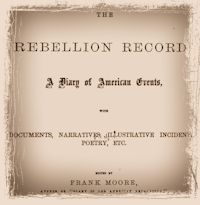November 5.—Lamar, Missouri, was this day captured by a body of rebel guerrillas under Quantrel, after a sharp fight with the garrison, consisting of only eighty State troops, under the command of Major Bruden, and partially destroyed by fire.—Leavenworth Conservative.
—A skirmish took place to-day at Barbee’s Cross-Roads, Virginia, between a force of Union troops, under the command of General Pleasanton, and a detachment of General Stuart’s rebel cavalry, resulting in the retreat of the latter with considerable loss.—(Doc. 29.)
—Salem, Virginia, was occupied by the National cavalry under General Bayard.—Curran Pope, Colonel of the Fifteenth regiment of Kentucky volunteers, died at Danville, Kentucky.— This day, while a battalion of General Shackleford’s cavalry, under the command of Major Holloway, was moving from Henderson to Bowling Green, Kentucky, a party of rebel guerrillas under Johnson attempted to surprise them, on the Greenville road, about seven miles from Madisonville. The attack was promptly met by the National forces, and the rebels were routed with the loss of eight killed and a large number wounded and captured. Colonel Fowler, who commanded the guerrillas, was among the killed. —Indianapolis Journal.
—This day Colonel Wyndham, of Bayard’s cavalry, had a spirited engagement with the rebel cavalry and artillery at New-Baltimore, Virginia, and succeeded in driving them off to their main body, near Warrenton.—General McClellan by direction of the President of the United States, was relieved from the command of the Army of the Potomac, and General Burnside was ordered to succeed him.—The monitor Weehawken was launched at Jersey City, New-Jersey.
—A fight took place to-day in the vicinity of Nashville, Tennessee, between the Union forces under General Negley, and a numerically much superior rebel force in two divisions, one of which was under the command of General J. H. Morgan, resulting in a repulse of the rebels with considerable loss.—(Doc. 28.)



